Specimen of the Week 319: The Camberwell Beauty
By ucwehlc, on 1 December 2017
Specimen of the week this week is a rare visitor to our shores, with a slightly misleading name. Today we venture south of the river in search of…
 Close
Close
News and musings from the UCL Culture team

By ucwehlc, on 1 December 2017
Specimen of the week this week is a rare visitor to our shores, with a slightly misleading name. Today we venture south of the river in search of…
By ucwehlc, on 8 September 2017
This week’s specimen has only recently entered the Grant Museum, and as soon as I saw it I wanted to know more. I did a little digging and this is what I found: Specimen of the Week is…
By Edmund Connolly, on 18 September 2014
Given their morbid tone why are they so popular? With modern attention spans dwindling perhaps their short punchy nature appeals over epic 3 hour long Shakespeares. Over in 90 minutes and loads of action, it’s an easy sell to people working late or in need of entertainment.
By ucwchrc, on 12 June 2014
One Day in the City Festival at UCL
 One Day in the City Festival taking place on Friday 13th June brings together a celebration of literature, art, music and culture in London. The framework is broad. Nick Shepley, the founder and organiser of the festival, and Teaching Fellow in English Literature at UCL, acknowledges this and says he has not tried to narrow it down to specific themes: “It is about opening out and trying to bring people to something that is a simple celebration of the city, its literature and art, and its cultural richness.” These are areas people work on everyday across various departments at UCL with their own audiences. Nick wants to harness this, and “break down the potential separation of audiences with the One Day festival, encouraging a wider demographic to come along.”
One Day in the City Festival taking place on Friday 13th June brings together a celebration of literature, art, music and culture in London. The framework is broad. Nick Shepley, the founder and organiser of the festival, and Teaching Fellow in English Literature at UCL, acknowledges this and says he has not tried to narrow it down to specific themes: “It is about opening out and trying to bring people to something that is a simple celebration of the city, its literature and art, and its cultural richness.” These are areas people work on everyday across various departments at UCL with their own audiences. Nick wants to harness this, and “break down the potential separation of audiences with the One Day festival, encouraging a wider demographic to come along.”
The festival’s centre will be in the UCL South Cloisters, decorated with a fun and artistic skyline created through lighting and architectural constructions. There will also be a multitude of balloons lining the Cloisters and leading the way to various events. These events will include a debate about taboo language with Inda Knight (journalist and author), Will Self (novelist) and Tim Clare (poet), a Caribbean carnival and seminars on topics related to creativity in London. In the UCL Art Museum there will be a talk by one of the Slade students, Helena Hunter, a poetry workshop and live performances as well as Slade students distributing prints of their work. For a full list, see the One Day website here.
The UCL Art Museum is located in the South Cloisters, so it will be at the hub of the festival’s activities. The remit of ‘One Day’ also links the artwork in the current exhibition at UCL Art Museum to the festival. This exhibition, called ‘Second Person Looking Out’, is the result of this year’s annual UCL Art Museum and Slade collaboration. It features an eclectic range of artwork from time-based media pieces to bronze sculpture and slate engravings. Have a look at my previous blog posts, reviewing the exhibition and talking to Ling the co-Curator, to find out more. (more…)
By ucwchrc, on 6 June 2014
Slade students, artists and curious print-making novices both from within and outside of UCL got together for a Pop Up lunch-time talk by artist and UCL Art Museum Curatorial Assistant, Ling Chiu on 27th May in the UCL Art Museum. When she is not at the Museum, Ling works at a printmaking studio in southeast London, helping artists such as Ray Richardson and Peter Blake to create prints in screenprint, etching and lithography.
Ling introduced us to fine art printing techniques, referring to the UCL Art Museum’s extensive collection of prints as inspirational examples. We were encouraged to look at a diverse selection before the workshop started, and then to reflect on them again after we had learnt about some of the printing techniques. This produced different engagements with the work, and was a fun way of relating techniques back to the art objects. The most popular print Ling displayed from the collection was Jack Miller’s ‘Weird Tales’ (UCL Art Museum 9239), which had a textured, velvet effect produced by combining flocking with screenprint techniques (think Andy Warhol meets 18th century floral wallpaper!).
The workshop followed on from an earlier session Ling had taken at the UCL Art Museum that looked at traditional printing methods typically used before 1850. This included relief printing (where the ink sits on top of the printing surface, and by which woodcuts and linocuts are made), intaglio printing (where the ink sits inside the printing plate, and is used to produce etchings and dry points), and planograph printing (which involves a chemical rather than physical change, and is used for lithography and screen-printing). With planographs, Ling used examples of her own work and some from the UCL Art Museum collection to describe how you work directly on the surface of the printing plate. You are also able to work on a large scale and in lots of colour as this is a painterly method of printing. However, each colour is drawn on a different stone, making the process relatively complex. One of Ling’s examples, Ludwig Grüner’s Sistine Chapel (UCL Art Museum 2872), took about 11 stones to achieve the subtle and extensive range of colours! (more…)
By ucwchrc, on 29 May 2014
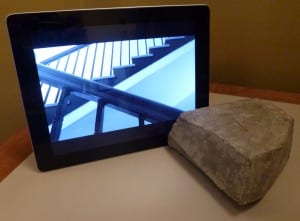
‘Getting close but then again not close at all’ by Olga Koroleva
The themes, materials and presentations of the annual collaborations have varied immensely, and this year there is a great diversity within the exhibition itself. The range of media is particularly striking, as is the way digital technologies have been used and portrayed to give new experiences of space – particularly the spaces of the UCL Art Museum itself.
There are four time-based media works and one beautifully crafted light box installation, giving emphasis to technological media within the show. However, an array of oil paintings, intricate drawings, etchings and even a bronze cast are also part of this exhibition.
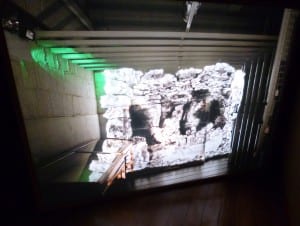
‘Entombment’ by Lara Smithson
Glowing at the back of the UCL Art Museum, in between the cupboards storing prints, is one of the most enchanting works of all. This is the light box, which constitutes the installation entitled ‘Entombment’ by Lara Smithson. It cleverly depicts the somewhat hidden UCL Art Museum painting store, giving us a glimpse of the racks of paintings mostly by former Slade students. This image has been overlaid with a painting by the artist herself, which results in a merging of different types of artistic spaces and temporalities. ‘Entombment’ seems to reveal things behind the surface (most notably the UCL painting store), while also reflecting on the (literal) surface of painting and the material properties – or potentials – of glass.
Another work that interrogates the materiality of its medium alongside its processes of production is a bronze cast work called ‘Fonte’ by Maxima Smith. This artwork achieves this using the word ‘fonte’ as both the subject matter and form of the work. In this way, the work prompts investigation into the etymology of the word ‘fonte’. The meanings include ‘to spring’ and ‘to pour’, actions that can be linked to the process and discourse of bronze casting itself.
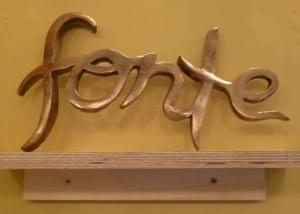
‘Fonte’ by Maxima Smith
A play with words is also immediately apparent in Katja Larsson’s hand carved slate, entitled ‘Hullmandel 4:3’. Here the artist has decontextualised a phrase she has taken from Charles Joseph Hullmandel’s 1835 lithography manual. Using this lithographic manual as a source is both a subtle and pertinent reference to the main body of the UCL Art Museum’s collection of artworks, which are prints. The artist’s chosen words are beautifully carved onto the slate – a process that mirrors the processes of printmaking. Using slate as the medium also reminds us of the lithographic process, being a traditional tool and material in lithographic production. This emphasis on process and action reflects one of the dominant themes in the entire exhibition.
 ‘Second Person Looking Out’ is on show at the UCL Art Museum weekdays 1-5pm until 13 June. On Friday 13 June the exhibition will become part of the One Day Festival in the City with several of the artists from the exhibition extending ideas from their work to engage visitors in interactive installations and other creative activities. More information on this to follow, so check this blog again soon.
‘Second Person Looking Out’ is on show at the UCL Art Museum weekdays 1-5pm until 13 June. On Friday 13 June the exhibition will become part of the One Day Festival in the City with several of the artists from the exhibition extending ideas from their work to engage visitors in interactive installations and other creative activities. More information on this to follow, so check this blog again soon.
Helen Cobby is a volunteer at UCL Art Museum and studying for an MA in the History of Art at UCL
By ucwchrc, on 6 May 2014
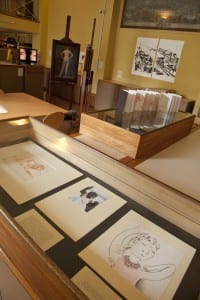 This is the sixth year of the Slade/UCL Collaboration. It started in 2009, encouraging Slade students to submit work inspired by art in the UCL Art Museum collection for an exhibition within the Museum’s space and the Strang Print Room. Initially, this involves Slade students attending meetings with the Art Museum staff and booking appointments to see certain works from the collection. The artists can also create pieces that are inspired by the tools, spaces, traditions and methodologies that the Museum offers. A good working relationship between the two institutions has been built up over the years.
This is the sixth year of the Slade/UCL Collaboration. It started in 2009, encouraging Slade students to submit work inspired by art in the UCL Art Museum collection for an exhibition within the Museum’s space and the Strang Print Room. Initially, this involves Slade students attending meetings with the Art Museum staff and booking appointments to see certain works from the collection. The artists can also create pieces that are inspired by the tools, spaces, traditions and methodologies that the Museum offers. A good working relationship between the two institutions has been built up over the years.
The Slade students enter the project out of their own choosing. It is a rich opportunity, allowing these students to learn how to produce work for outside of the studio and how to present their work to curators, which includes writing an in-depth proposal. The collaboration also enables a chance to work with a professional archive. In return, the project helps to introduce new audiences to the Art Museum, to change and develop the use of its spaces, and encourage creative engagement with the collection. (more…)
By ucwchrc, on 27 March 2014
It’s Museum Week, which is proving to be a brilliant opportunity to get to know new galleries, explore a museum’s history and join in with celebrating the wonderful work that museums do – not to mention the art they have and the imaginative spaces they create!
There has been a different theme each day – and today it’s ‘Behind The Art’. Here at UCL Art Museum we thought this would be the perfect opportunity to rediscover some of the many female artists that studied at The Slade next door and whose work is part of the UCL Art Museum collections. We’re thinking Gwen John, Winifred Knights and Paula Rego. (more…)
By ucwchrc, on 6 February 2014
 Working up to the event on Wed 26th Feb 6.30 – 7.30pm, in UCL Art Museum.
Working up to the event on Wed 26th Feb 6.30 – 7.30pm, in UCL Art Museum.
On 26th February there is the chance to meet the artist and Slade School PhD Graduate Kai Syng Tan and take part in her experimental, multidisciplinary event based around the positive powers of running. This is the opportunity to learn about running as a potentially playful and subversive activity within an artistic framework.
Kai is sprinting forward with latest research that focuses on the body and its dialogue with technology and social media networks. Her website creatively communicates this unusual project, which is constantly evolving. Come expecting to be made curious, surprised and energized.
Intrigued to find out more before the event, I met up with Kai to talk about how her work explores notions of playfulness, natural endorphins and the meaning of life.
You have many different roles and identities, being an artist, educator and researcher. How do you see them interacting and influencing each other?
Many artists today have multiple identities. I have been an artist for nearly 20 years, but I have done many different things within this role. It involves showing my work in public spaces and online in spaces not always considered part of the art world. As a new media artist I have also had a parallel career; lecturing is how I bring home the bacon. (more…)
By ucwchrc, on 22 November 2013
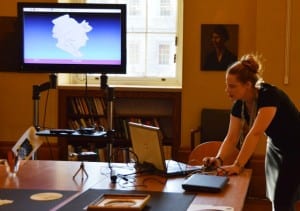 Mona Hess, Research Assistant for 3D imaging and project co-ordinator of the Petrie Museum’s 3D imaging project, curated a Pop-Up display this November on 3D printing and scanning at UCL Art Museum. 3D printing is a new and high profile phenomenon that started in 2007. The aim of the Petrie research has been to make use of the opportunities this technology creates in the museum space, such as engaging with a diverse and wide audience through the creation of 3D objects.
Mona Hess, Research Assistant for 3D imaging and project co-ordinator of the Petrie Museum’s 3D imaging project, curated a Pop-Up display this November on 3D printing and scanning at UCL Art Museum. 3D printing is a new and high profile phenomenon that started in 2007. The aim of the Petrie research has been to make use of the opportunities this technology creates in the museum space, such as engaging with a diverse and wide audience through the creation of 3D objects.
This Pop-Up workshop wove together film clips of high resolution colour laser 3D scanning to demonstrate how different types of technology works, as well as addressing techniques first-hand with the use of a mini hand scanner with the use of a low cost hand scanner based on near-infrared detection originally used for motion tracking. (more…)